Introduction
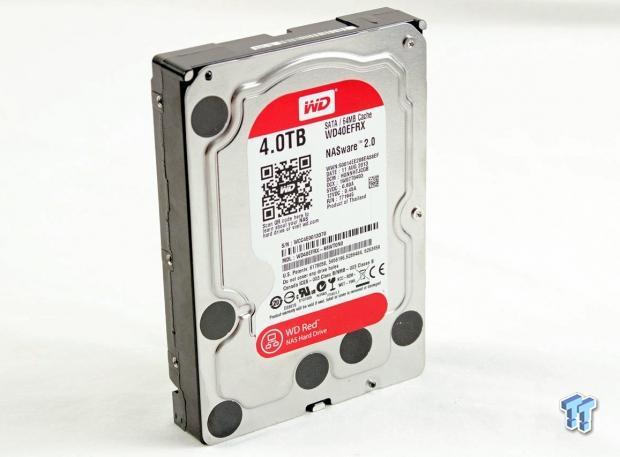
In the past, many have opined that the advent of the cloud was going to gut the NAS market, but a multitude of factors have risen to speed the deployment of NAS into numerous applications. The NAS market has been experiencing explosive growth lately, and is projected to continue its meteoric rise well into the future.
Metered connections, slow download speeds, and privacy concerns have conspired to slow the growth of the cloud, while the capabilities of the humble NAS have expanded tremendously. Today's NAS systems are used in the home and in an increasing number of SOHO and datacenter applications. The expansive NAS deployment into a multitude of applications has created a blurry product segmentation line that WD has addressed with a whole family of products.
For consumer and SOHO applications, more customers are opting to purchase diskless NAS units that provide several benefits. Purchasing HDD's separately is usually a more economical route and allows for flexibility in drive selection. Users can also purchase storage as needed, creating a pay-as-you-go pricing structure. The Red series was developed specifically to cater to this user base, with the noticeable exception of a capacity point above 3TB.
WD addresses this with the release of the new 4TB WD Red. The Red series is geared for use in 1-5 drive bay NAS or RAID applications. WD also provides the Se for use in 6-12 bay NAS, and the Re and Xe drives for entry to high-end datacenter use. The Red now comes in capacities of 1TB, 2TB, 3TB and 4TB in a 3.5" form factor. There is also the inclusion of a new 2.5" SFF drive for users with 750GB and 1TB capacities.
The WD Red features a SATA 6Gb/s connection and 64MB of cache. While typical HDDs sport an actual RPM rating, the Red series merely lists the speed as IntelliPower, though many speculate it spins between 5,400 and 5,900 RPM. This lower platter speed dramatically reduces power consumption.
The Red series also offers a multitude of ingredients that tailors them specifically for NAS usage. An adjustable TLER (Time Limited Error Recovery) is set for seven seconds as a default, and prevents the drive from being dropped in the event of an error, which triggers a rebuild mode in RAID usage. IntelliPark (head parking) is disabled as Red HDD's are designed for 24x7 use.
NASware 2.0 improves performance, reliability, and protects the drive from losing data in the event of a power loss. Vibration is introduced from the other neighboring drives in multi-bay NAS units, and can reduce the lifespan of the HDD and degrade performance. 3D Active Balance Plus is an enhanced dual-plane balance technology that reduces vibration and noise in multi-drive systems.
This mixture of NAS-specific features creates an HDD that fills the gap between desktop and nearline drives. Extensive compatibility testing with all major NAS vendors ensures compatibility with nearly all NAS units, which can be a dicey proposition with desktop HDD's. An increased MTBF of 1,000,000 hours and a three-year warranty wrap up the features of the Red Series, let's take a look where it stands in the WD family of products.
WD NAS Family
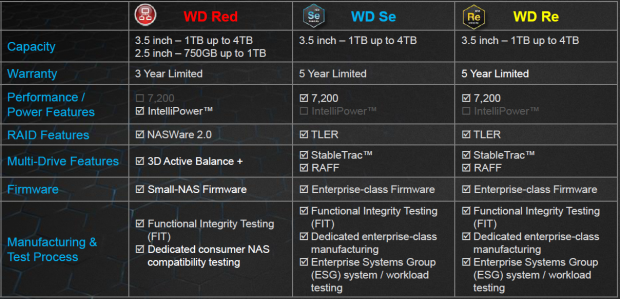
WD has an expansive NAS family of HDD's to suit every need. In today's product evaluation, we compare the performance of the Red, Se and Re.
The primary purpose of the Red HDDs is to serve the NAS and RAID user base. This is accomplished through a mixture of features that are tailored for small-scale NAS usage. The recommended limit of 1-5 drives per NAS or RAID group limits the Red's to home and SOHO (Small Office/Home Office) usage models. The Red HDD's include IntelliPower, NASware 2.0, and 3D Active Balance to suit them for NAS usage. Typical desktop HDD's do not include these features. The Red HDDs have a three-year warranty period.
For larger deployments of 6-12 hard drives, the WD Se series provides optimal storage for NAS and scale-out architectures. The 7,2000 RPM Se is designed for Small-Medium Business (SMB) and large-scale enterprise use with a moderate workload requirement. The Se drives spin at 7,200 RPM and feature enterprise-specific characteristics such as StableTrac, RAFF, TLER and enterprise-class firmware. The Se series also has a longer warranty period of five years.
The Re series spins at 7,2000 RPM and offers many of the same features as the Se model, but is designed for heavier workloads. The Re series is intended for entry to high-end datacenter NAS use in rack-mount environments with large numbers of HDDs. These drives feature many of the same features of the Se, but also come in with the option of SAS for high-availability and SATA 3GB/s.
The final offering from WD comes in the form of the 10,000 RPM XE, which is designed for high performance storage. These drives are only available with a SAS connection, and feature a five-year warranty period.
WD Red Internals
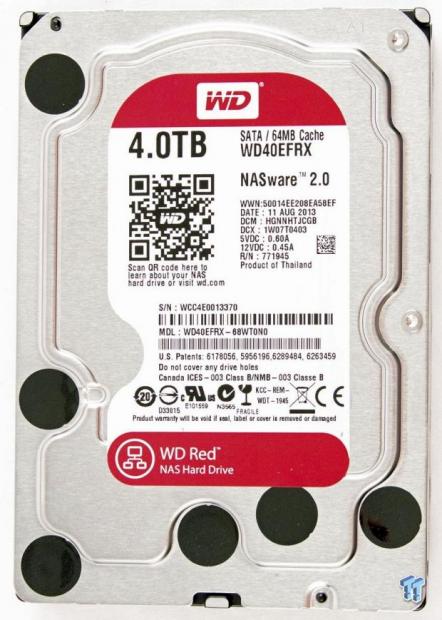
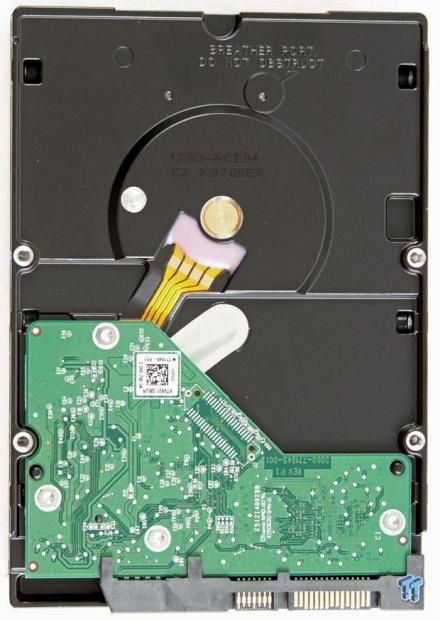
The WD Red comes in a standard 3.5" form factor and is emblazoned with the signature red branding. The bottom of the drive has the PCB with the components turned inward, facilitating thermal dissipation into the case of the drive.

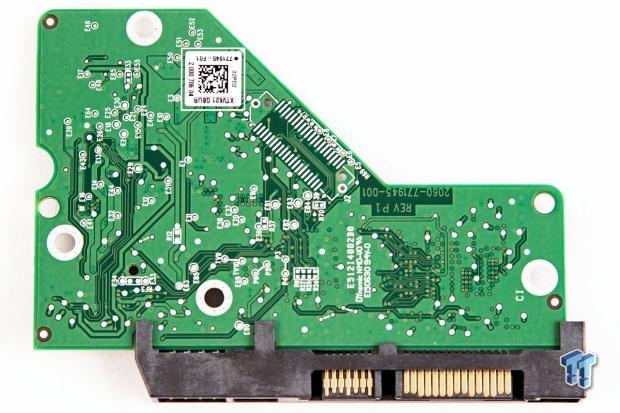
Upon removal of the PCB, we note the thermal pad over the controller. This mates with a metal pad on the case of the PCB through the foam padding. The foam padding is utilized to negate vibration.
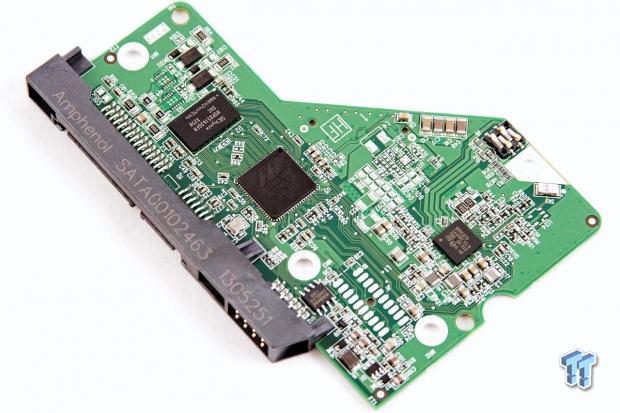
The Marvell controller dominates the center of the PCB, with the 64MB cache module to the left. There is also a drive motor controller and the four pins that connect to the motor.
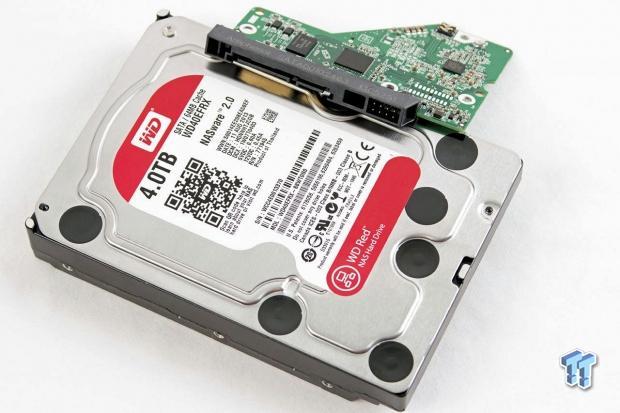
The WD Red features a standard 6Gb/s SATA port.
Test System and Methodology
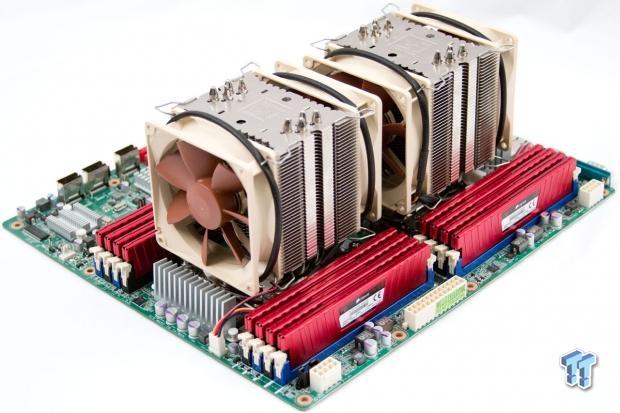

We utilize a new approach to HDD and SSD storage testing for our Enterprise Test Bench, designed specifically to target long-term performance with a high level of granularity.
Many testing methods record peak and average measurements during the test period. These average values give a basic understanding of performance, but fall short in providing the clearest view possible of I/O QoS (Quality of Service).
'Average' results do little to indicate the performance variability experienced during actual deployment. The degree of variability is especially pertinent, as many applications can hang or lag as they wait for I/O requests to complete. This testing methodology illustrates performance variability, and includes average measurements, during the measurement window.
While under load, all storage solutions deliver variable levels of performance. While this fluctuation is normal, the degree of variability is what separates enterprise storage solutions from typical client-side hardware. Providing ongoing measurements from our workloads with one-second reporting intervals illustrates product differentiation in relation to I/O QOS. Scatter charts give readers a basic understanding of I/O latency distribution without directly observing numerous graphs.
Consistent latency is the goal of every storage solution, and measurements such as Maximum Latency only illuminate the single longest I/O received during testing. This can be misleading, as a single 'outlying I/O' can skew the view of an otherwise superb solution. Standard Deviation measurements consider latency distribution, but do not always effectively illustrate I/O distribution with enough granularity to provide a clear picture of system performance. We use histograms to illuminate the latency of every single I/O issued during our test runs.
We measure power consumption during test runs. This provides measurements in time-based fashion, with results every second, to illuminate the behavior of power consumption in steady state conditions. Power consumption can cost more over the life of the device than the initial acquisition price of the hardware itself. This significantly affects the TCO of the storage solution. We also present IOPS-to-Watts measurements to highlight the efficiency of the storage solution.
We conduct our tests over the full LBA range to allow each HDD to highlight its average performance. Short stroking can increase performance at the loss of capacity. The first page of results will provide the 'key' to understanding and interpreting our new test methodology.
4K Random Read/Write
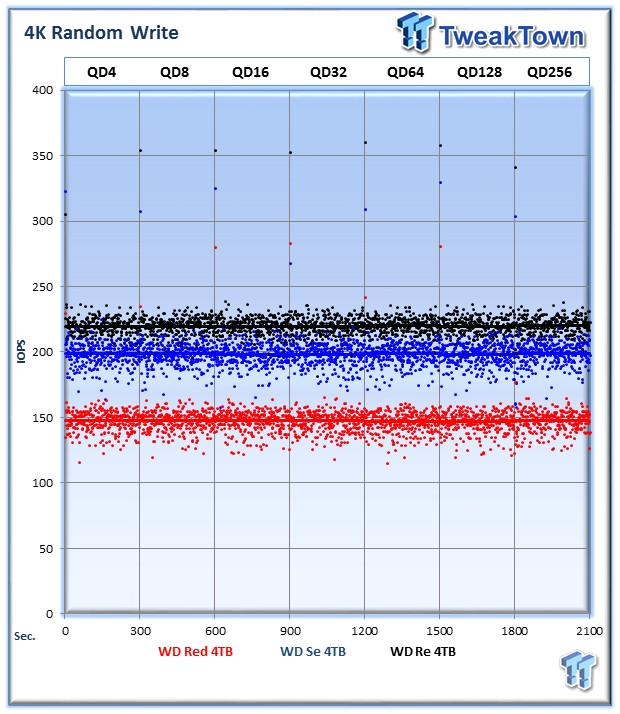
Each QD for every parameter tested includes 300 data points (five minutes of one second reports) to illustrate the degree of performance variability. The line for each QD represents the average speed reported during the five-minute interval.
4K random speed measurements are an important metric when comparing drive performance, as the hardest type of file access for any storage solution to master is small-file random. One of the most sought-after performance specifications, 4K random performance is a heavily marketed figure.
The WD Red falls into a predictable spot behind the faster Se and Re drives. The Red averages 147 IOPS in the 4K random write test.
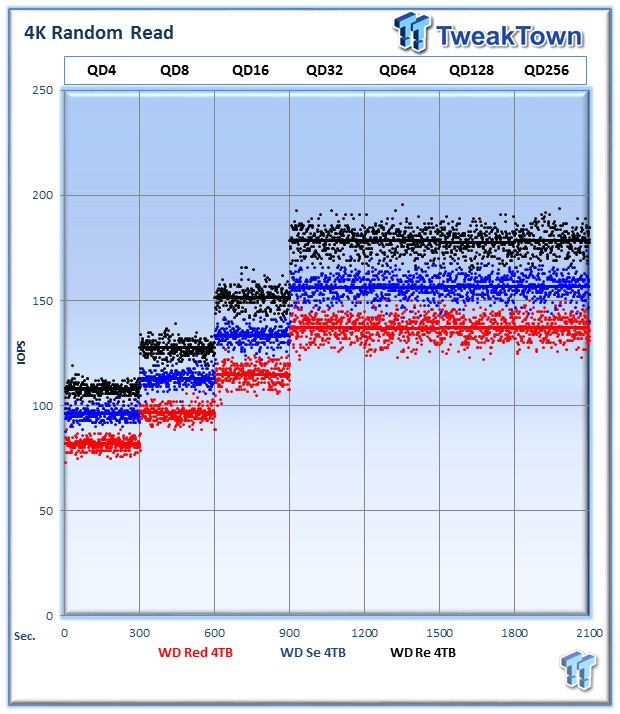
The Red scores closely with the faster drives, and averages 136 IOPS at QD256.
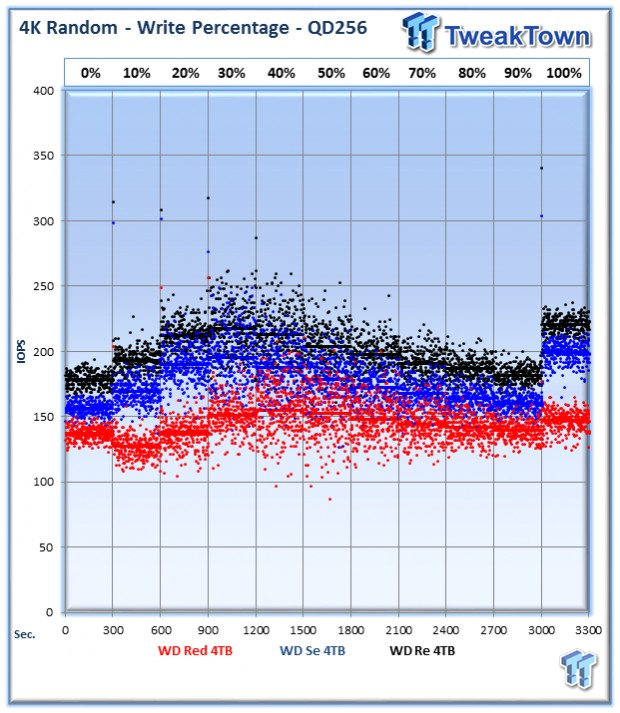
Our write percentage testing illustrates the varying performance of each solution with mixed workloads. The 100% column to the right is a pure write workload of the 4K file size, and 0% represents a pure 4K read workload.
The WD Red provides solid performance as we mix in heavier write workloads, closely matching the Se until we reach the pure write workload.
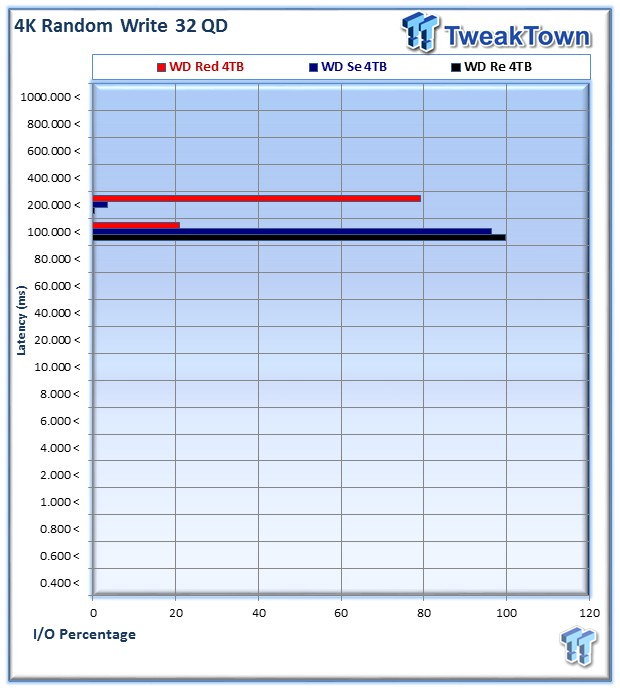
The Red delivers 79.1% of I/O's in the 200-400ms range, and 20.8% at 100-200ms.
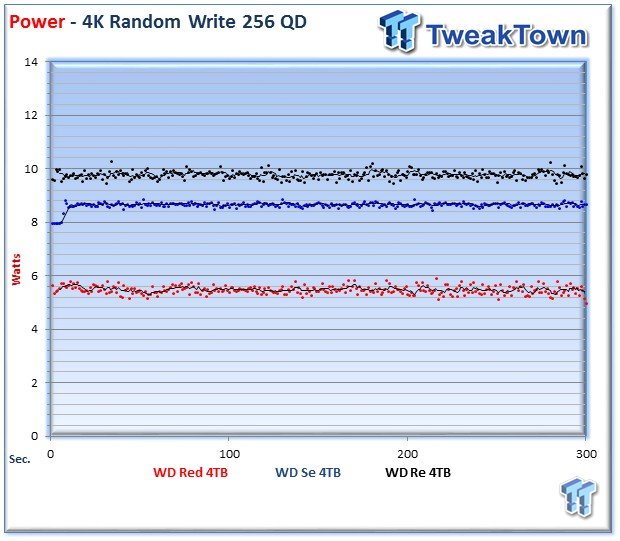
We record the power consumption measurements during our test run at QD256.
The Red averages 5.48 Watts during the measurement window, significantly lower than the faster drives.
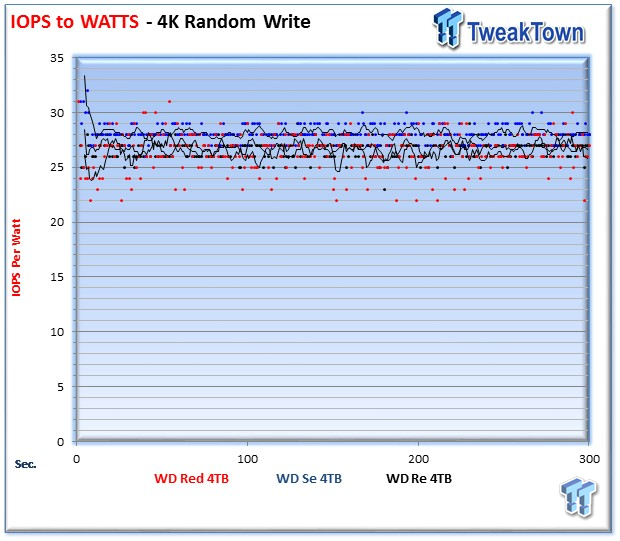
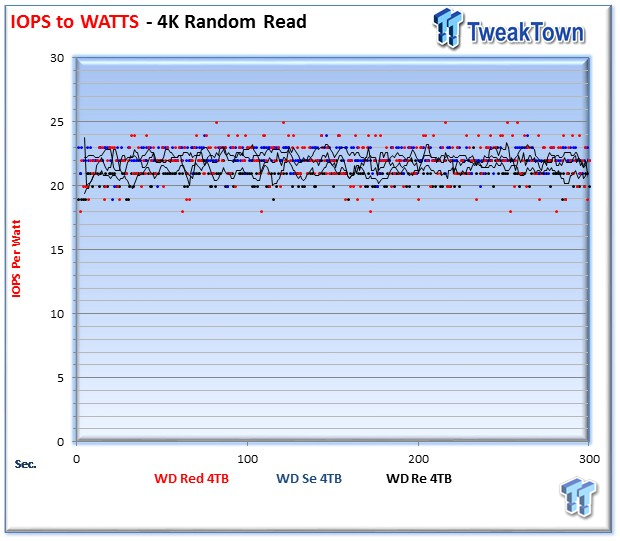
IOPS to Watts measurements are generated from data recorded during our test. The Red delivers an average of 26.4 IOPS per Watt for 4K random writes, and 22 IOPS per Watt for 4K random read access. It remains remarkably close in IOPS to Watts in comparison to the faster HDDs.
128K Sequential Read/Write
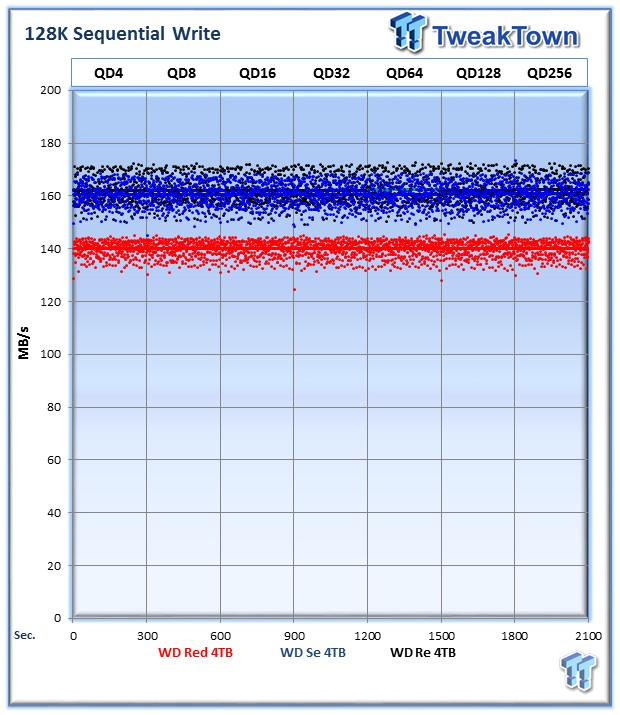
The 128K sequential speeds reflect the maximum sequential throughput of the HDD using a file size encountered in a normal NAS usage.
The Red averages 139 MB/s at QD256. There is a clear segmentation here, with the two 7,200 RPM drives providing incrementally faster write speed.
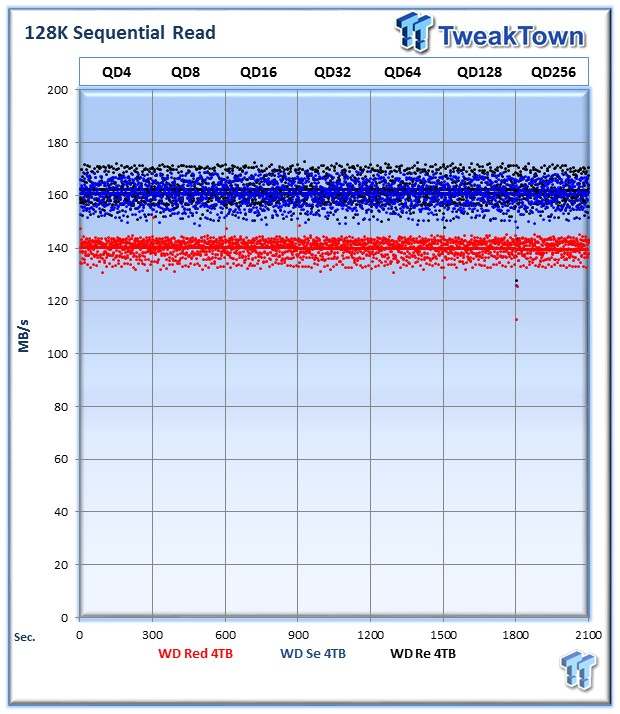
The Red averages 139 MB/s in sequential write speed during the measurement window, but again the two 7,200 RPM drives offer the same performance with a sequential workload.
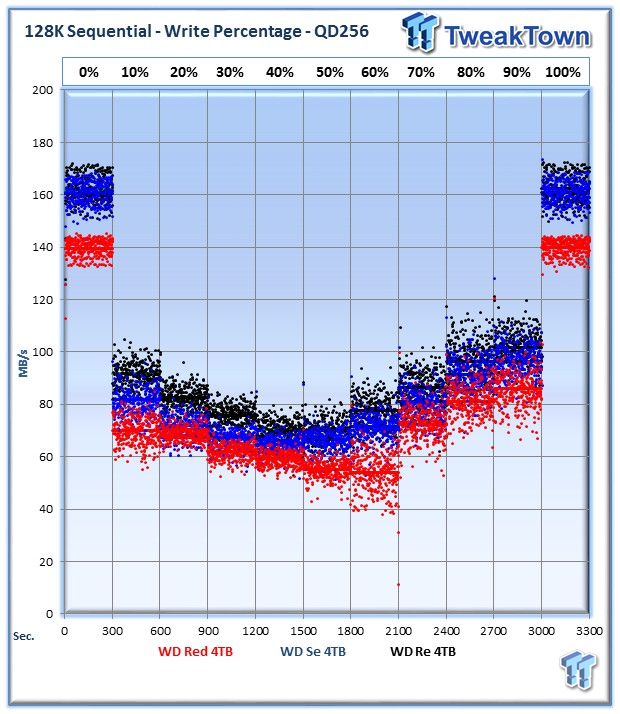
The Red posts excellent performance in our mixed read/write testing, nearly matching the Re and Se. The Red lags behind in pure read and write workloads, but in the middle ground, it performs very well.
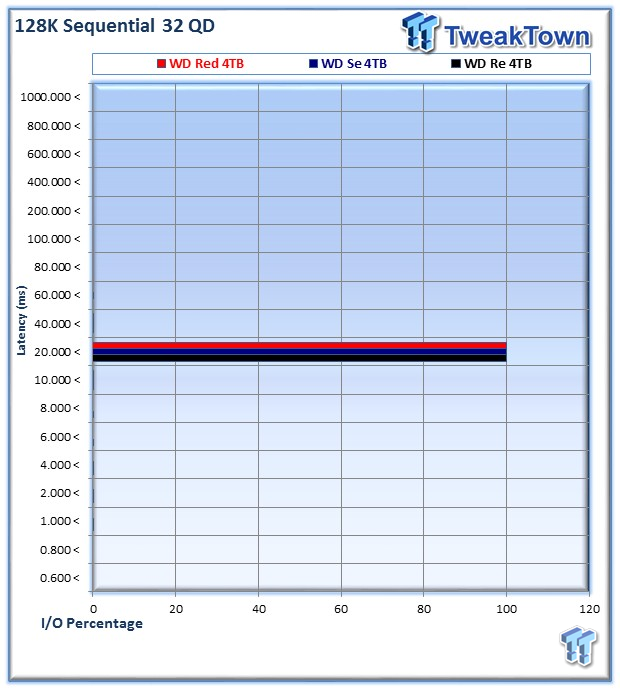
The Red offers up 99.9% of requests in the 20-40ms range, matching the faster HDDs in our sequential latency test.
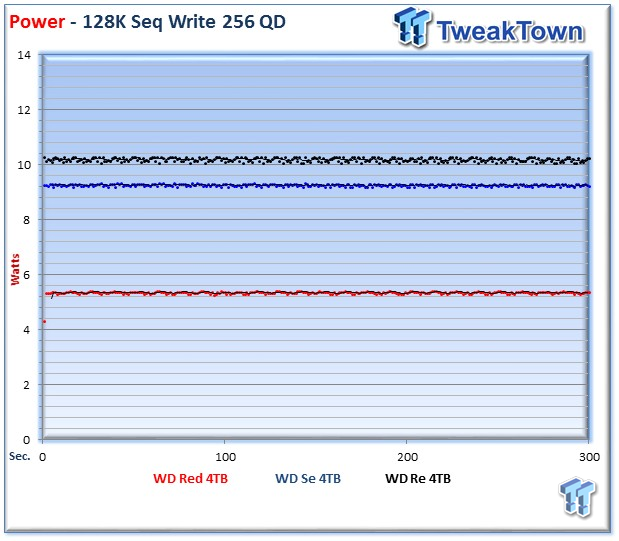
The Red averages 5.34 Watts during sequential write testing, providing a much lower power consumption figure than the competing drives. Considering the excellent performance in mixed workloads and write latency this low power consumption is a huge bonus.
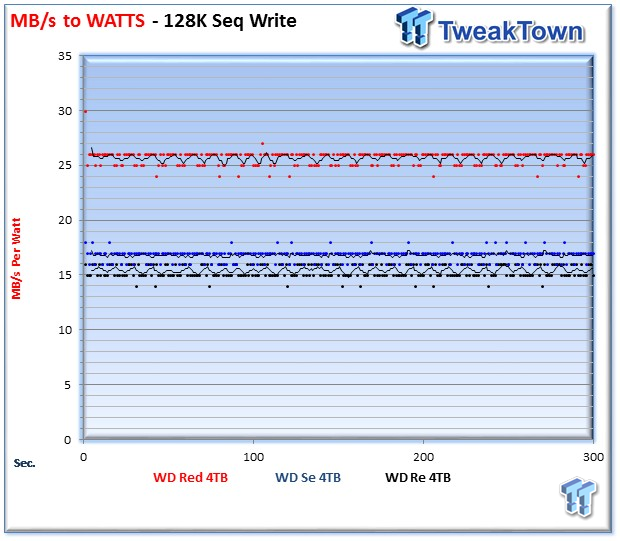
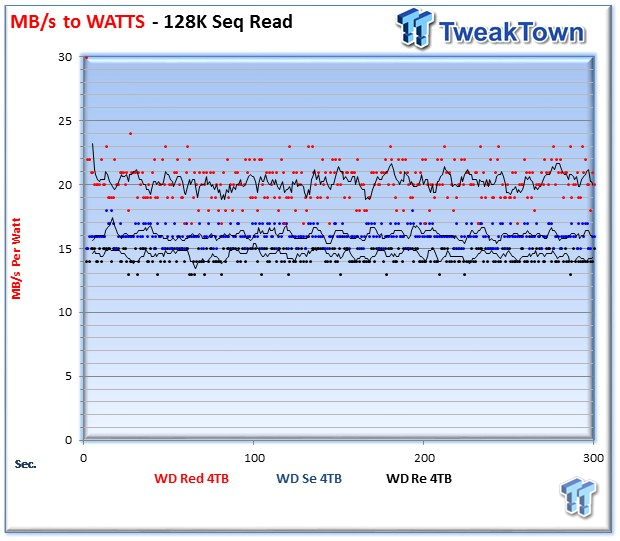
The Red provides a dominating IOPS to Watt ratio in both sequential read and write workloads, surprisingly besting both enterprise-class HDDs, which are designed with power efficiency as a major focal point. The Red provides an average of 25.6 MB/s per Watt for 128K sequential read/write.
Database/OLTP and Fileserver
Database/OLTP
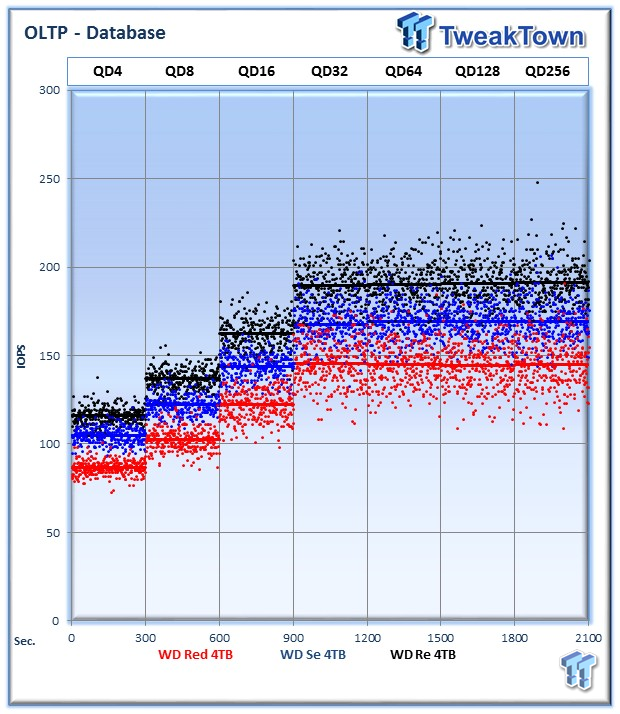
This test emulates Database and On-Line Transaction Processing (OLTP) workloads. OLTP is in essence the processing of transactions such as credit cards and high frequency trading in the financial sector. Databases are the bread and butter of many deployments. These are demanding 8K random workloads with a 66% read and 33% write distribution that can bring even the highest performing solutions down to earth.
The Red averages 144 IOPS at QD256.
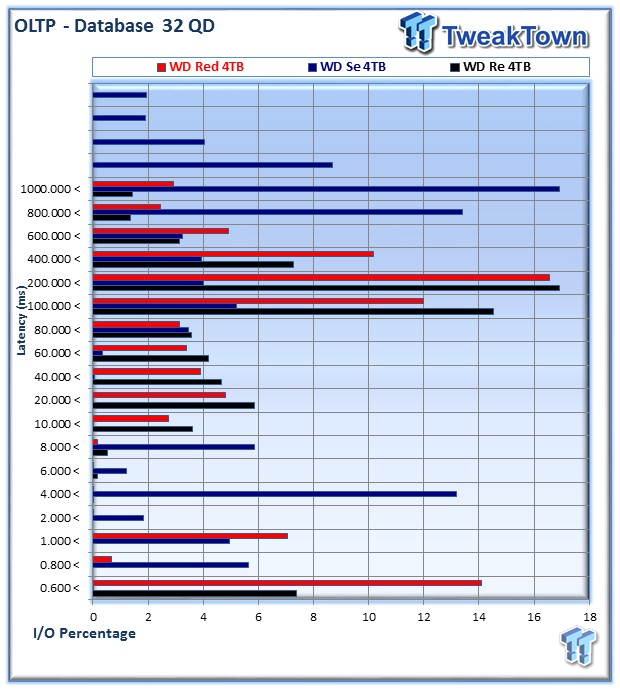
The Red exhibits an almost bi-modal distribution of write latency in this mixed workload, with a distribution on either end of the latency spectrum. If the Red does dynamically alter the speed of the platters, we may be witnessing vestiges of a speed adjustment during this workload.
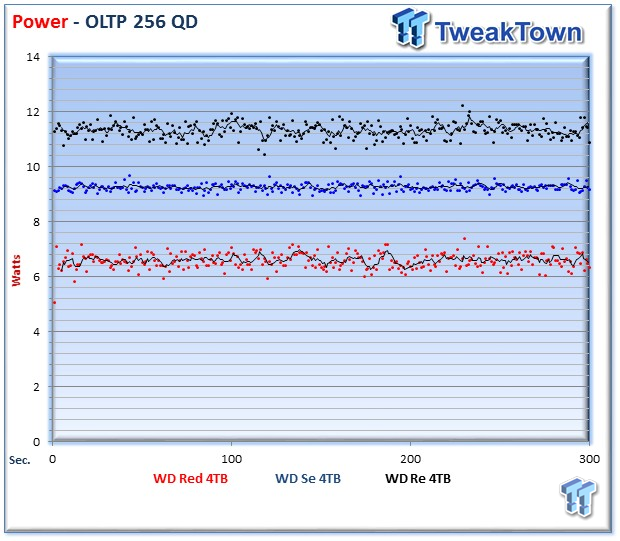
The Red averages 6.59 Watts during the test period.
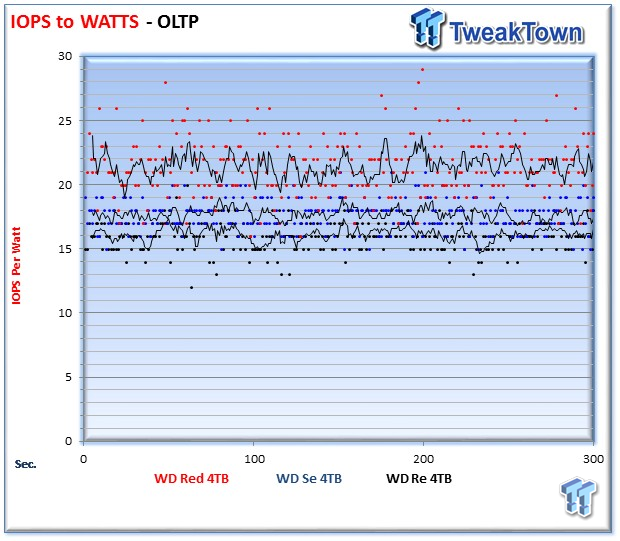
The Red averages 144 IOPS per Watt in our Database/OLTP testing, once again leading the pack in IOPS to Watts measurements.
Fileserver
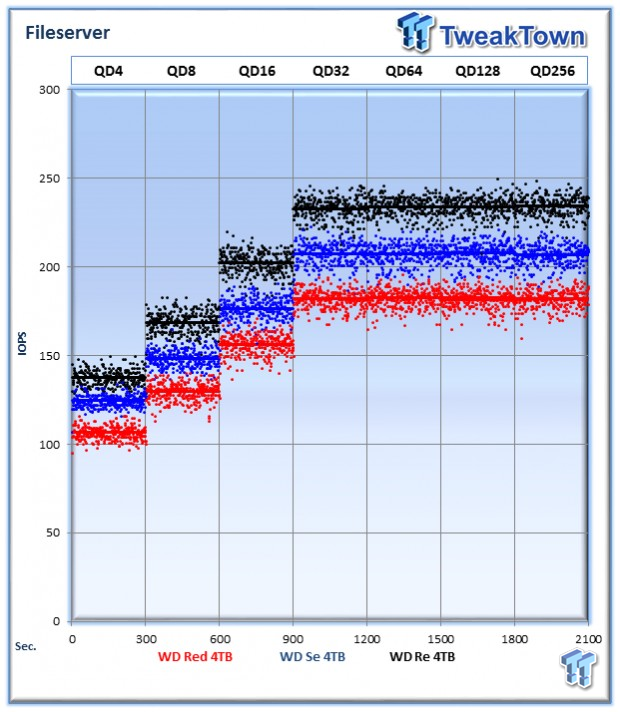
The File Server profile represents typical file server workloads that are very relevant to NAS usage. This profile tests a wide variety of different file sizes simultaneously to simulate multiple users with an 80% read and 20% write distribution.
The Red averages 182 IOPS at QD256, easily outstripping the speed of most consumer NAS Ethernet connections.
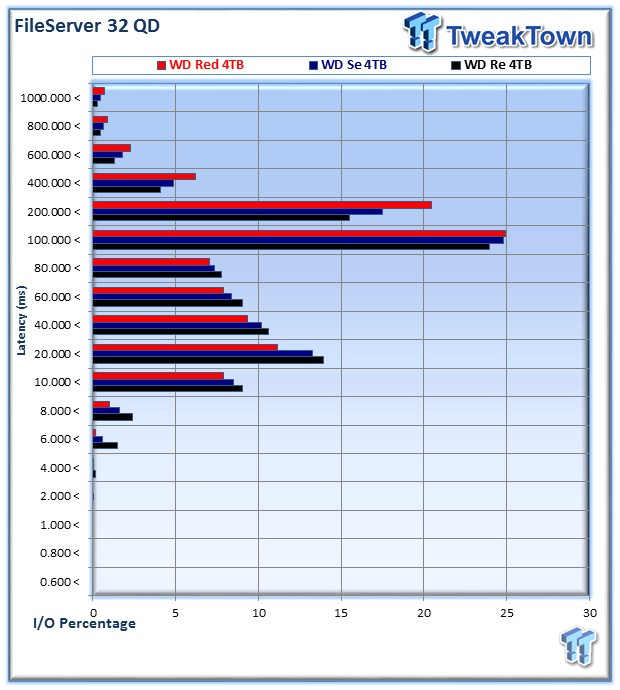
The Red is very well suited to the Fileserver application, which comes in handy in a NAS environment. The Red delivers a range of latency that is within striking distance of its faster family members.
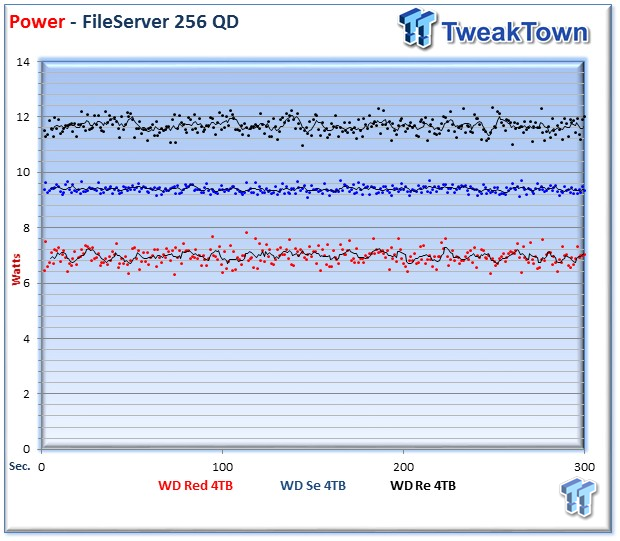
The Red averages 6.97 Watts during the test.
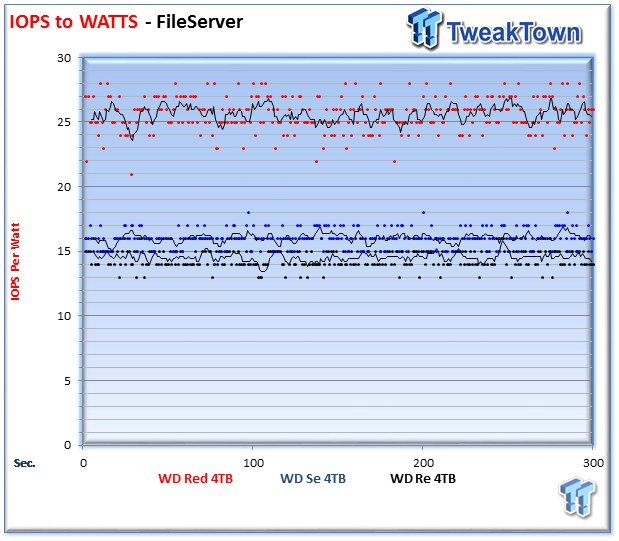
The Red averages an impressive 25.63 IOPS per Watt during the measurement window, far outstripping the faster HDDs.
Emailserver and Webserver
Emailserver
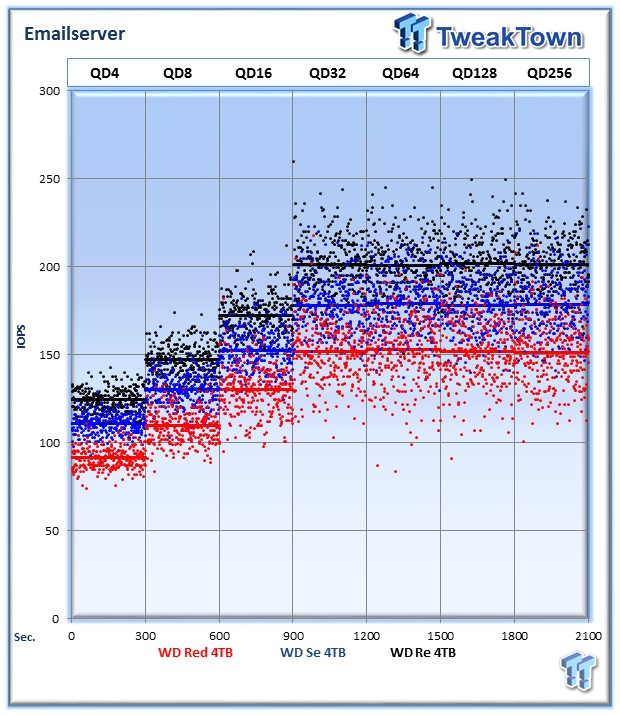
The Emailserver profile is a very demanding 8K test with a 50% read and 50% write distribution. This application is indicative of the performance of the solution in heavy write workloads.
The Red averages 151 IOPS at QD256.
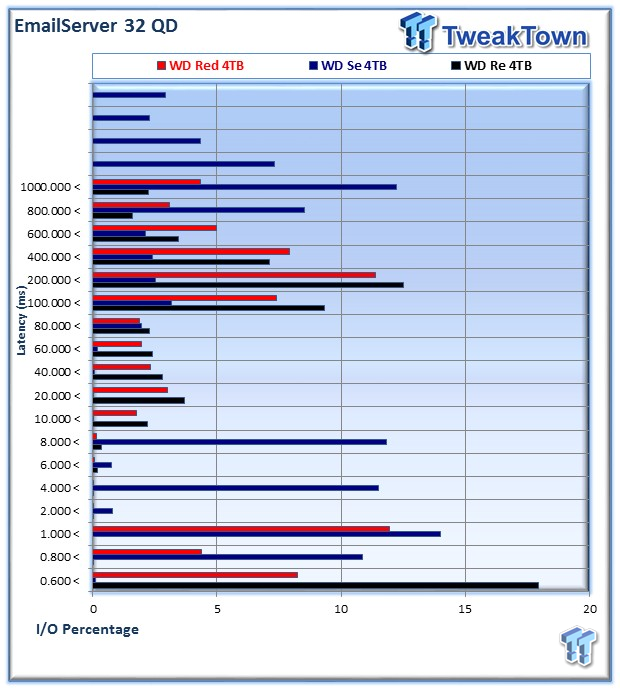
The Red surprisingly outperforms the Se at this test.
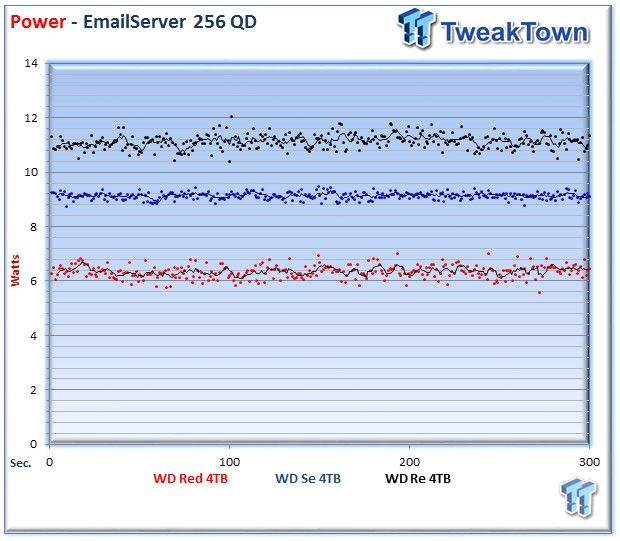
The Red averages a miserly 6.35 Watts during the test.
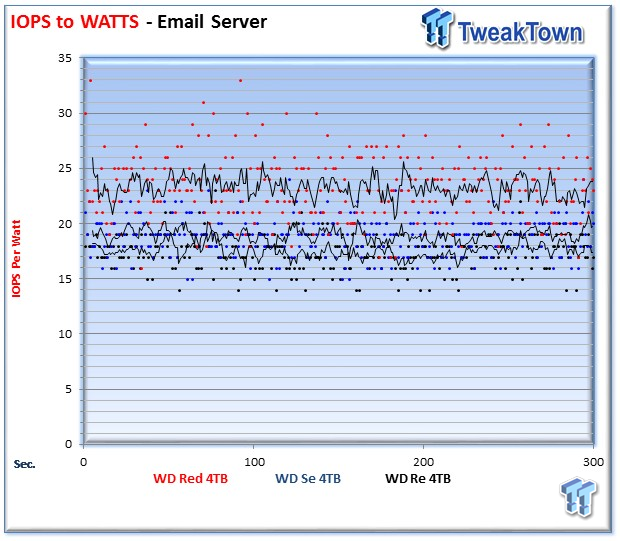
The Red averages 23.29 IOPS per Watt.
Webserver
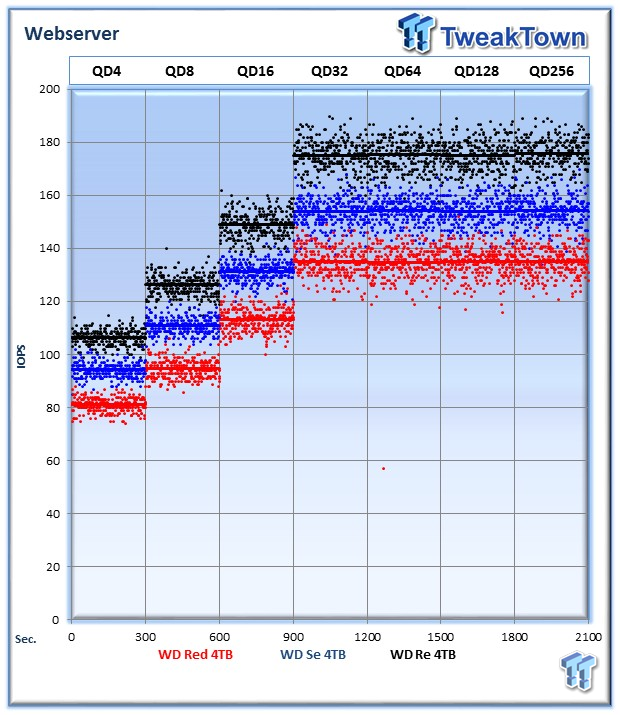
The Webserver profile is a read-only test with a wide range of file sizes. Web servers are responsible for generating content for users to view over the internet, much like the very page you are reading. The speed of the underlying storage system has a massive impact on the speed and responsiveness of the NAS, and thus the end-user experience.
The Red averages 134 IOPS at QD256.
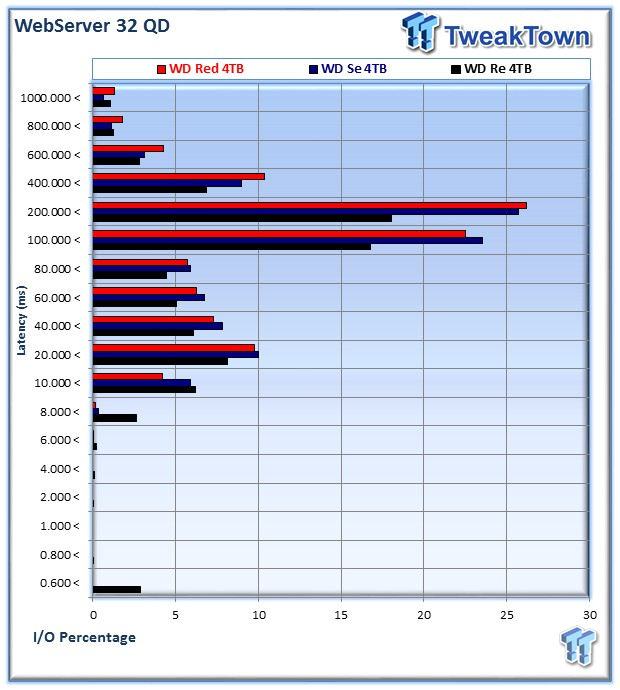
The Red again exhibits a similar latency performance envelope to its faster brethren, though the Re manages to pull away with some access at .6ms or below.
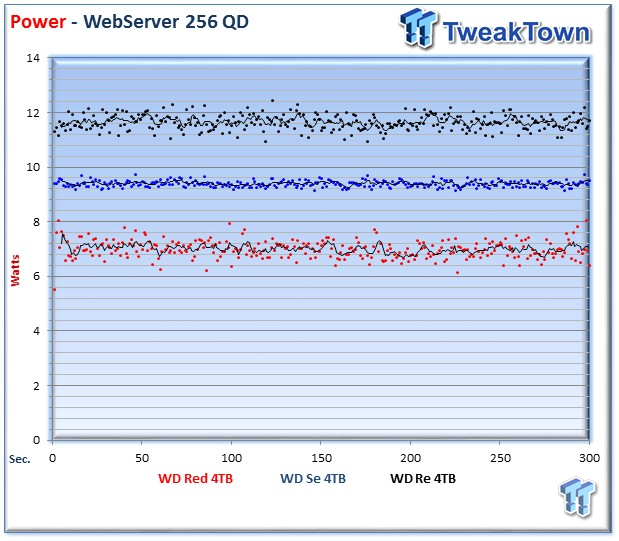
The Red averages a conservative 7 Watts during the test.
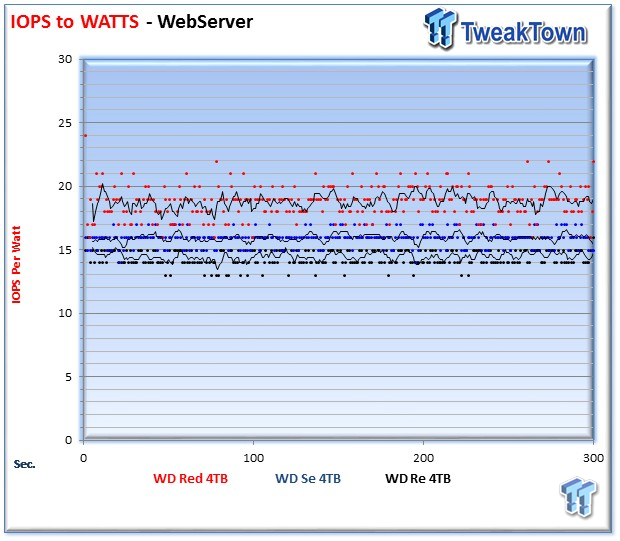
The Red closes out our testing with an average of 18.8 IOPS per Watt during the measurement window, easily beating the competition.
Final Thoughts
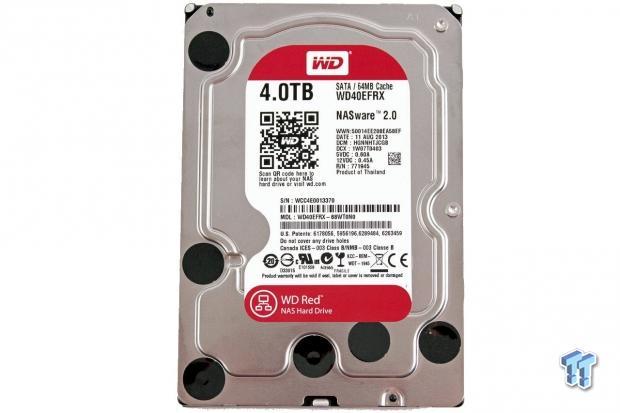
The WD Red is designed specifically to address the needs of the NAS market with advanced features such as TLER, IntelliPower, NASware 2.0, and 3D active Balance Plus. These features address NAS-specific problems that plague desktop drives pushed into service in NAS and RAID configurations. The Red series also features a 35% increase in MTBF to over a million hours that speaks volumes to the reliability of the drive in 24x7 usage models.
We compared the Red to the higher-class Se and Re drives in our tests. The Re and Se are designed for datacenter usage and very demanding workloads. They also feature a higher 7,2000 RPM speed than the Red, creating quite the challenge for the Red. The higher RPM of the Se and Re predictably resulted in a performance advantage in our workloads, but looks can be deceiving. In pure read and write 4k and 128k workloads, the faster drives pulled ahead. However, in mixed workloads, the Red closed the gap and was surprisingly close in performance.
The WD Red may have incrementally slower performance metrics than its brethren, but in a typical consumer NAS environment this is a non-issue due to bandwidth constraints. Many NAS users are constrained by a single gigabit connection with a practical throughput limit around 115 MB/s. The key for the Red is to deliver performance where it counts, and blistering throughput isn't a real necessity.
Latency is always pertinent, and the Red exhibited exceptional latency performance in spite of its lower speed, and in the many workloads was close to the enterprise HDDs. The exceptional latency performance of the Red will result in snappy use in day-to-day workloads.
For a NAS user, power consumption is a concern due to the 24x7 nature of NAS systems. Power consumption also equates to heat, which can lower component life. Heat can also result in extra noise due to the NAS fans running at a higher speed to keep the drives cool. While this would not be a concern in a datacenter, a NAS under the desk needs to be whisper quiet and preferably not dump a lot of heat into the room.
The Red addresses these issues well, with lower power consumption than the datacenter-class comparison HDDs. The power measurements for the Red were amazingly low, and when we measured the efficiency with in IOPS to Watts testing, the Red outperformed datacenter drives designed for the ultimate in power efficiency.
The Red is also a good fit for the price conscious, especially when considering the enhanced features. The three-year warranty matches the standard for consumer drives, and WD also provides free phone support for Red users. Finally, the Red is extensively pre-qualified with all major NAS manufacturers, so there is no doubt that this drive is on the compatibility list.
Overall, the WD Red wraps reliability, performance, efficiency, and power consumption in a reliable package with an acceptable price point that will make it a go-to drive for many NAS and RAID users.

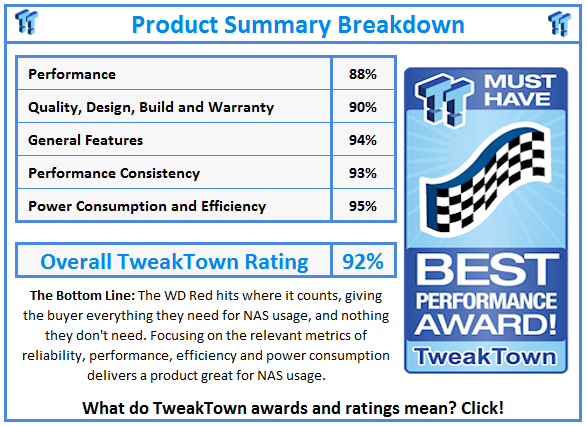
 United
States: Find other tech and computer products like this
over at
United
States: Find other tech and computer products like this
over at  United
Kingdom: Find other tech and computer products like this
over at
United
Kingdom: Find other tech and computer products like this
over at  Australia:
Find other tech and computer products like this over at
Australia:
Find other tech and computer products like this over at  Canada:
Find other tech and computer products like this over at
Canada:
Find other tech and computer products like this over at  Deutschland:
Finde andere Technik- und Computerprodukte wie dieses auf
Deutschland:
Finde andere Technik- und Computerprodukte wie dieses auf